- Army
- Air Defense Systems
- Anti-tank systems and vehicles
- Armored Vehicles
- Armoured personnel carriers
- Artillery Vehicles and Weapons
- Command Post
- Communication Vehicles and Systems
- Electronic Warfare
- Engineer | Maintenance Vehicles
- Infantry Fighting Vehicles
- Main Battle Tanks
- Missiles
- Tactical and Logistic Vehicles
- Radars
- Unmanned Systems
- Weapons
- Navy
- Air
Bradley M2A3
Bradley M2A3 IFV
Infantry Fighting Vehicle tracked armored - United States

Description
The Bradley M2A3 IFV Infantry Fighting Vehicle is an improved version of the Bradley M2A2. Since its initial production in 1981, the Bradley has been continually improved to meet the requirements of the changing battlefield. Bradley M2A3, the latest development program, incorporates improvements including enhancements intended to improve lethality, mobility, survivability, and sustainability. Additionally, these enhancements are intended to provide increased situational awareness and digital command and control capabilities. Approximately 1,602 Bradley A2s will be remanufactured into A3s, including fire support and air defense derivatives. Engineering and manufacturing development of the A3 upgrade will continue through 1999. In March 1994, the United States Army awarded a contract to United Defense, Limited Partnership, to begin the engineering and manufacturing development phase. In June 1997, the Army approved the first vehicles and low-rate production began in July 1997. The Bradley entered into service with the U.S. Army in April 2000. The system was approved for full-rate production in May 2001. The Bradley M2A3 was used by the U.S. Armed Forces during the war in Iraq.
Bradley M2 IFV variants:
- Bradley M2: The basic production model, first fielded in 1981
- Bradley M2A1: It's a further development of the standard vehicle Bradley M2 with an improved ATGM (Anti-Tank Guided Missile) launcher, with greater accuracy and a new sight system.
- Bradley M2A2: Introduced in 1988, new engine, new armor with protection against 30 mm APDS rounds and RPGs (or similar anti-armor weapons).
- Bradley M2A3: Introduced in 2000, the A3 upgrades make the Bradley IFV totally digital and upgrade or improve existing electronics systems through improving target acquisition and fire control, navigation, and situational awareness. Also, the survivability of the vehicle is upgraded with a series of armor improvements, again both passive and reactive, as well as improved fire-suppression systems and NBC equipment.
- Bradley BCP: The Bradley BCP is a Command Post tracked armored vehicle based on the chassis of the armored infantry fighting vehicle Bradley.
- Bradley M6 Linebacker: The Bradley-Linebacker Short-Range Air Defense (SHORAD) system is essentially a United Defense Bradley infantry fighting vehicle with the twin Raytheon Systems Company TOW anti-tank guided missile system replaced by a pod containing four Stinger fire-and-forget Surface-to-Air Missiles (SAM).
- Bradley M7 FIST: Bradley FIST (Fire Support Team) vehicle for the US Army field artillery.
- Bradley AMEV: The Bradley AMEV delivers life-saving combat medical support and protection for casualties, evacuees and combat medics while providing mobility and survivability equal to the supported Abrams and Bradley-equipped maneuver force.
- Bradley AMTV: The Bradley AMTV provides combat medical support to the Heavy Brigade Combat Team. The AMTV provides the capability to place forward surgical teams closer to the point of injury, allowing advanced trauma management and intervention treatment on today’s battlefield.
- Bradley Mortar Vehicle: The Bradley Mortar Vehicle’s large interior volume enables the vehicle to carry up to 115 rounds of 120mm mortars, which facilitates the crew’s ability to provide a longer duration of sustainable fires.
Technical Data
| Armament |
|
The M2A3 Bradley has exactly the same armament as the previous version Bradley M2A2. The M2A3 Bradley is armed with an ATK Gun Systems Company M242 25 mm Bushmaster Chain Gun with a 7.62 mm M240C machine gun mounted coaxially to the right of the main armament. A total of eight smoke grenade launchers are mounted on the forward part of the turret, four to each side of the main armament.
|
| Design and protection |
|
The layout of the M2A3 Bradley is similar to the standard version of Bradley M2A2. The hull and the turret of the Bradley are constructed of welded aluminum and supplemented at critical locations by spaced laminate armor. In addition, Bradley M2A3 has appliqué steel armor which can be fitted with additional passive armor or Explosive Reactive Armour (ERA). The ERA consists of 96 tiles fixed to the sides, turret, and front of the vehicle, which enhances protection against a variety of anti-armor munitions including shoulder-launched Rocket Propelled Grenades (RPG).
|
| Mobility |
| The Bradley M2A3 uses the same power pack and transmission that the Bradley M2A2. The vehicle can run at a maximum road speed of 61 km/h with a maximum cruising range of 400 km. The Bradley M2A3 can climb a 60% slope, 30% side slope, 91 cm vertical wall and can cross a trench of approximately 2,54m. The Bradley M2A3 is fully amphibious and propelled in the water by its tracks at a maximum speed of 6.4 km/h. |
| Combat Equipment |
| The M2A3 is equipped with a digital electronic architecture incorporating onboard subsystem monitoring, diagnostics/ prognostics, and an Army Technical Architecture (ATA) compliant Command and Control software suite that is fully interoperable with M1 main battle tanks. The gunner is equipped with a Raytheon integrated sight unit (ISU) which includes a day / thermal sight of magnification ×4 and ×12. An optical relay provides the image of the gunner's sight to the commander. The gunner also has periscopes for forward and side observation. A daytime sight system for the gunner or commander is provided as backup to the primary sight. The M2A3 Bradley uses a position-navigation subsystem that incorporates a GPS, an inertial navigation unit (INU), and a vehicle motion sensor (MVS), which, in addition to allowing accurate own-vehicle navigation, allows accurate position reporting and handoff of designated targets to other units via FBCB2 (Battlefield Command Information System). The M2A3 Bradley incorporates the Improved Bradley Acquisition Subsystem (IBAS) and the Commander’s Independent Viewer (CIV) mounted to the right side of the turret. Both include a second-generation FLIR and an electro-optical/TV imaging system, and the IBAS also has direct-view optics (DVO) and an eye-safe laser rangefinder (ELRF). The CIV allows the commander to scan for targets and maintain situational awareness while remaining under armor and without interfering with the gunner’s acquisition and engagement of targets. Some Bradley M2A3s are also equipped with two antennas mounted at the rear of the top turret which are used to jam IED (improvised explosive devices) signals or RCIED (remote-controlled improvised explosive devices). |
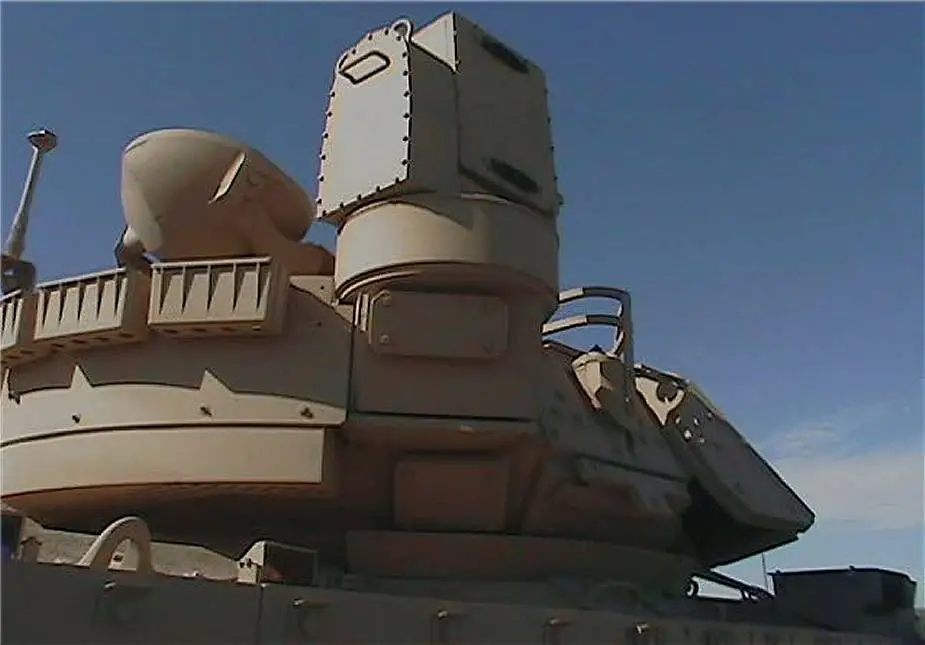 |
| The main recognition feature of the M2A3 is the Commander's Independent Viewer (CIV), at the right rear of the turret. |
Specifications
| Armament | Armor |
| One 25mm M242 cannon, one 7.62mm M240C coaxial machine gun, 2 TOW launchers, and 2x4 smoke grenade launchers | Spaced laminate armor. RPG and 30 mm APDS all-around protection (with armor upgrades) and shell splinters 155mm. In option, passive armor or Explosive Reactive Armour (ERA) |
| Country users | Weight |
| United States | 29,030 kg and 32,659 kg with armor tiles |
| Designer Country | Speed |
| United States | 61 km/h |
| Accessories | Range |
| NBC protection system, thermal day/night vision, automatic fire extinguishers, GPS, inertial navigation unit, laser rangefinder, vehicular intercommunication system, Integrated Combat Command and Control software,tactical display | 400 km |
| Crew | Dimensions |
| 3 + 7 soldiers | Length: 6.55 m; Width: 3.28 m; Height: 3.38 m |
Details View
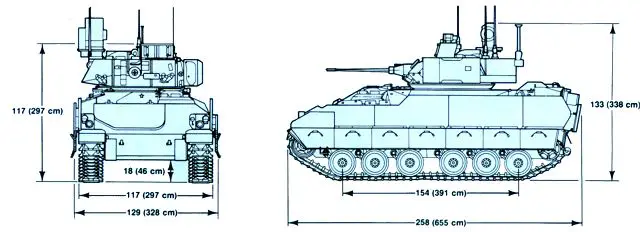 |
|
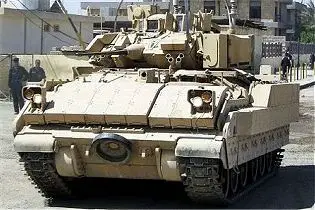 |
 |
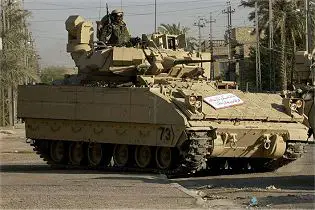 |
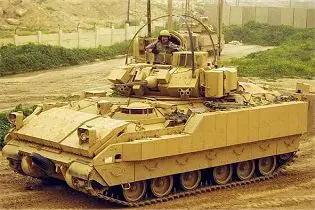 |
Pictures - Video



























